 |
 |
 |
| |
76 Week Follow-up of HBeAg-Positive Chronic Hepatitis B Patients Treated with Telbivudine, Adefovir or Switched from Adefovir to Telbivudine
|
| |
| |
Reported by Jules Levin
EASL, April 11-15, 2007
Barcelona, Spain
P Marcellin, HLY Chan, C-L Lai, M Cho, Y-M Moon, Y-C Chao, J Heathcote, R Myers, G Harb, N Brown
Authors concluded: telbivudine provided greater and more rapid antiviral effects compared with adefovir through 1 year of treatment. For patients with suboptimal response to adefovir, switching from adefovir to telbivudine after 24 and 52 weeks provided a substantial additional reduction of serum HBV DNA that persisted through week 76.
The study enrolled 135 adults with HBeAg+ chronic HBV with HBV DNA >6 log c/ml and serum ALT 1.3-10xULN. Patients were randomized (2:1) to adefovir or telbivudine for 24 weeks, with a secondary randomization (1:1) of adefovir recipients to continue adefovir or switch to telbivudine after week24. The primary endpoint was HBV DNA reduction at week24. After week52, most patients received telbivudine in an open-label extension trial. The effects of switching from adefovir to telbivudine in patients with suboptimal response to adefovir (HBV DNA >3 log at week 24 or 52 weeks) were analyzed.
At week24, mean HBV DNA reduction from baseline was significantly greater with telbivudine vs adefovir (-6.30 vs -4.97) log c/ml; p<0.01). Mean viral load decreased sharply after switching to telbivudine at week 24. Among the 78% of patients in the adefovir group with suboptimal response at w24 (HBV DNA >3 c/ml), those switching to telbivudine displayed an additional 2.1 log mean reduction between week 24 and week 52, vs 0.9 log for patients who remained on adefovir. Similarly, among adefovir recipients with persistent suboptimal response at week 52, a 2.1 log decrease in viral load occurred between week 52 and week 76 after switching to telbivudine. In patients receiving continuous telbivudine, the mean HBV DNA reduction from baseline was 6.3 log, 6.8 log, and 7.2 log at weeks 24, 52, and 76, respectively. Serum HBV DNA was non-detectable (<300 c/ml) in 39%, 60%, and 72%, respectively, at these time points.
RESISTANCE: no resistance data was reported in the presentation at EASL. At the AASLD meeting in 2006 two years results were reported from the GLOBE Trial, which was a large international study of 1300 patients comparing telbivudine and lamivudine: excerpted from NATAP report--
Cumulative Resistance at Year Two
ITT Population
2 Virologic Breakthrough analyses:
- Per protocol: HBV DNA returns to >5 log, or within 1 log of Baseline
- 1 log above nadir
Resistance = breakthrough with resistance mutations
HBeAg+ patients on telbivudine had 17.8% cumulative resistance at year 2 per protocol & 21.6% using the 1 log above nadir approach. For lamivudine it was 30.1% & 35%, respectively. For HBeAg-negatives, taking telbivudine, 7.3% per protocol had resistance & 8.6% had resistance using the 1 log above nadir approach. For lamivudine, it was 16.6% & 21.9%, respectively.
Additional Resistance Findings
Week 24 viral load predicts telbivudine resistance at Year 2:
-- about 80% of resistance from patients with viral load >3 logs at Week 24
-- Minimal resistance when PCR-negative at Week 24: 2% for HBeAg negative, 4% for HBeAg positive
No breakthrough with telbivudine in first 24 weeks
M204I substitution in HBV Pol OR wild-type sequence has been found in all telbivudine patients with confirmed virologic breakthrough.
Some M204I breakthrough patients have secondary mutations, of uncertain significance (no breakthrough with these mutations alone).
Study Presented at EASL 2007
Inclusion Criteria
HBeAg positive
Nucleos(t)ide-naive
Compensated liver disease
HBV DNA > 106 copies/mL by COBAS Amplicor PCR
ALT 1.3-10 x ULN
Study Design
Phase IIIB Randomized, Open Label, Multicenter Study

-- 135 patients randomized in 018 study
-- 121 patients received telbivudine in 022 follow-on study
ENDPOINTS
Primary Endpoint
Serum HBV DNA reduction at week 24
Selected Secondary Endpoints
- Undetectable serum HBV DNA by PCR (< 300 copies/mL)
- ALT normalization
- HBeAg loss and seroconversion
Treatment Failure and Resistance
- Viral Breakthrough
- Resistance
- Primary treatment failure
Safety Analysis
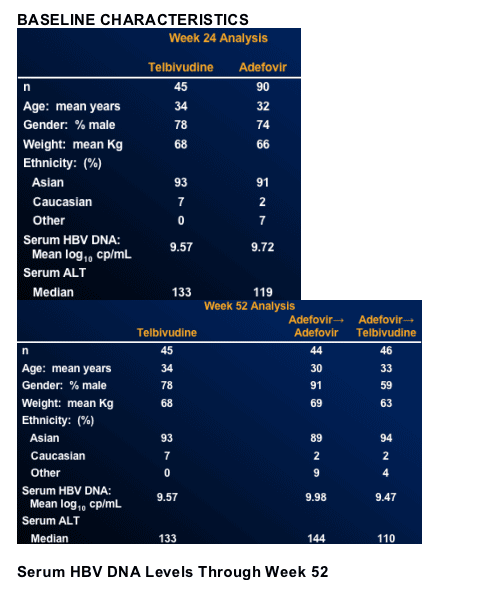
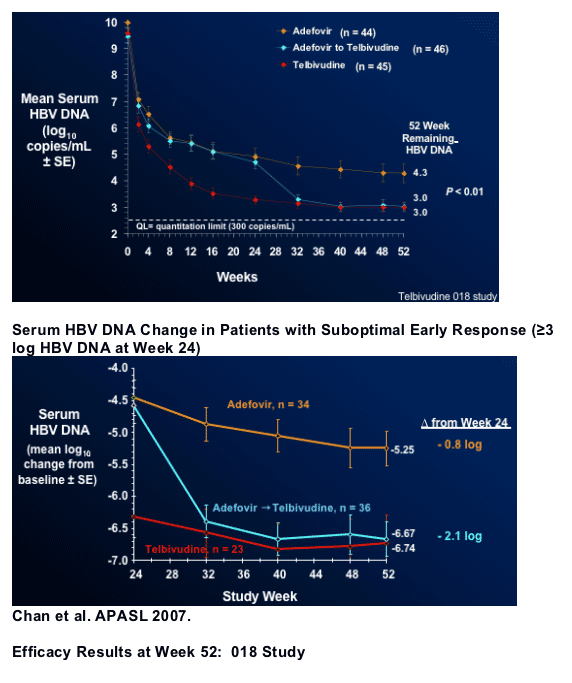
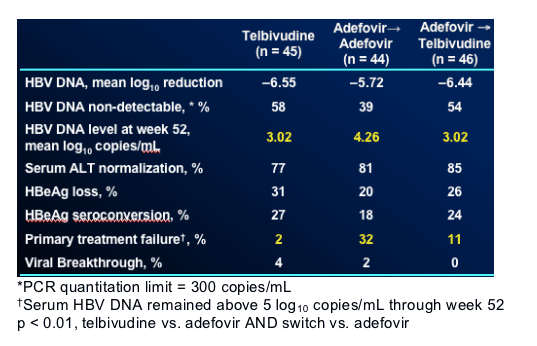
Extended Telbivudine Therapy - 022 Study
Preliminary analysis of ongoing study data
Extended Telbivudine Therapy - 022 Study
At week 52, most patients completing the 018 study enrolled in the 022 study:
-- Without treatment interruption
-- Received open-label telbivudine, regardless of prior therapy in 018
At week 76 (combined 018 + 022 treatment duration), virologic responses were assessed, comparing:
-- Patients switched from adefovir to telbivudine at week 52
-- Patients maintained on continuous telbivudine from baseline (week 0) through week 76
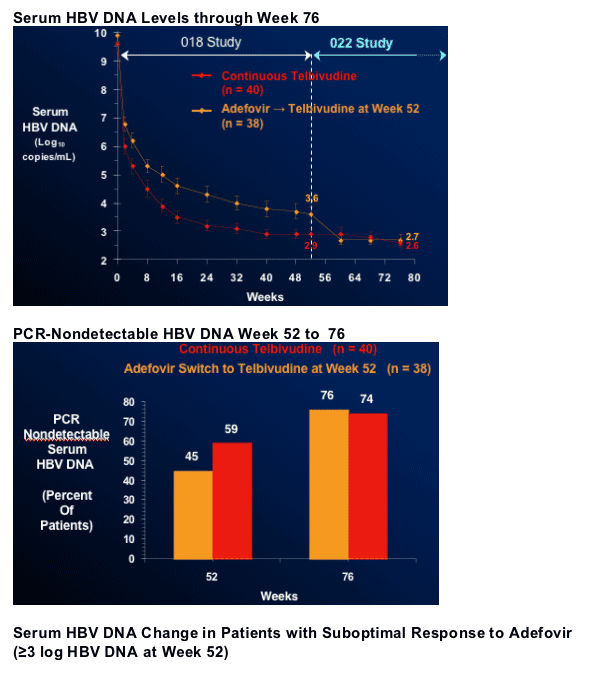
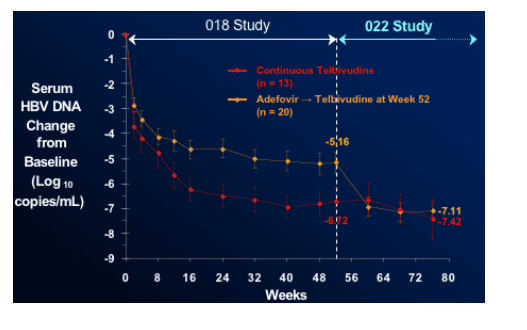
Safety Summary
Telbivudine vs Adefovir in HBeAg+ Chronic Hepatitis B
Both drugs were well tolerated
No drug-attributed serious adverse events
Similar clinically adverse event profiles
-- Adverse events for both agents were primarily those associated with viral respiratory infections and gastrointestinal complaints
Grade 3 or 4 neutropenia in two patients
-- One telbivudine recipient and one patient in the switch group; both events resolved at follow-up 6 days later, with continued treatment
|
| |
|
 |
 |
|
|